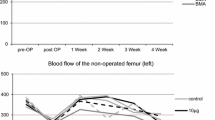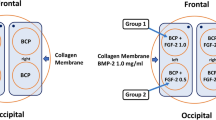Abstract
Introduction
A recent histopathological and immunohistochemical study has proved that the addition of concentrated growth factors (CGF) to the Masquelet’s technique contributes to the quality of the membrane formed, in respect of inducing inflammation and proliferation, maintaining vascularization on large diaphyseal bone defects, and increasing the number of stem cells. The aim of the study is comparison of radiological results of this combination treatment by micro-CT.
Materials and methods
The study was planned on a critical bone defect model in rabbit radius. Group I and Group III were the control groups to which only the Masquelet’s technique is applied. Group II and Group IV were CGF groups in addition to the Masquelet’s technique. CGF was prepared by centrifugation of rabbit’s own blood. For early phase, Groups I and II were evaluated in the 8th week, while for late phase, Group III and Group IV were evaluated in the 12th week. Groups were compared in terms of bony union radiologically by micro-CT(μCT) (New Bone Volume (NBV), Total Bone Volume (TBV) and NBV/TBV) and histopathologically.
Results
The structural parameters, including NBV, TBV, NBV/TBV were higher in the early- (8th week) and late-phase (12th week) CGF group. There was no statistically significant difference between CGF and control groups in early phase, (p = 0.153), while in late phase, CGF group was significantly higher of new bone volume than the control group, 246.3 mm3 (196.1–258) and 169.6 mm3 (154.3–235.9), respectively (p = 0.028). For early phase, control group was significantly lower than late-phase control group, 121.8 mm3 (88.8–144.4) and 169.6 mm3 (154.3–235.9), respectively (p = 0.006). The ratio of New Bone Volume to Total Bone Volume (NBV/TBV ratio) in CGF groups was significantly higher compared to the control groups 27.3% (24.7–29.6), 35.3% (32.1–38.6) (p = 0.032) and 39.7% (36.7–41.6), 55.3% (52–57.5) (p = 0.002), respectively. Histopathologically, Microscopic New Bone Formation had no statistically significant difference between control and CGF groups in early phase (8th week) (p = 0.153), while in late phase (12th week), CGF group had significantly higher amount of new bone formation than the control group, 0.29 µm2 (0.27–0.36), 0.51 µm2 (0.42–0.59), respectively (p = 0.008).
Conclusion
The addition of CGF to the Masquelet’s technique is an important method for supporting new bone formation in large diaphyseal bone defects.
Level evidence
Level III, therapeutic/care management.



taken from the iliac crest on the contralateral side of the bone and then was applied to the bone defect


Similar content being viewed by others
References
Masquelet AC, Begue T (2010) The concept of induced membrane for reconstruction of long bone defects. Orthop Clin North Am 41(1):27–37
Giannoudis PV, Kanakaris NK, Dimitriou R, Gill I, Kolimarala V, Montgomery RJ (2009) The synergistic effect of autograft and BMP-7 in the treatment of atrophic nonunions. Clin Orthop Relat Res 467(12):3239
Klaue K, Knothe U, Anton C, Pfluger DH, Stoddart M, Masquelet AC et al (2009) Bone regeneration in long bone defects: tissue compartmentalisation? In vivo study bone defects in sheep. Injury 40(4):95–102
Pelissier P, Martin D, Baudet J, Lepreux S, Masquelet A-C (2002) Behaviour of cancellous bone graft placed in induced membranes. Br J Plast Surg 55(7):596–598
Yılmaz O, Özmeriç A, Alemdaroğlu KB, Celepli P, Hücümenoğlu S, Şahin Ö (2018) Effects of concentrated growth factors (CGF) on the quality of the induced membrane in Masquelet’s technique–An experimental study in rabbits. Injury 49(8):1497–1503
Rodella LF, Favero G, Boninsegna R, Buffoli B, Labanca M, Scari G et al (2011) Growth factors, CD34 positive cells, and fibrin network analysis in concentrated growth factors fraction. Microsc Res Tech 74(8):772–777
Eyrich D, Göpferich A, Blunk T (2006) Fibrin in tissue engineering. Adv Exp Med Biol 585:379–392
Gaßling VL, Acil Y, Springer IN, Hubert N, Wiltfang J (2009) Platelet-rich plasma and platelet-rich fibrin in human cell culture. Oral Surg Oral Med Oral Pathol Oral Radiol Endod 108(1):48–55
Fang D, Long Z, Hou J (2020) Clinical application of concentrated growth factor fibrin combined with bone repair materials in jaw defects. J Oral Maxillofac Surg 75(9):1–11
Shim JH, Moon TS, Yun MJ et al (2012) Stimulation of healing within a rabbit calvarial defect by a PCL/PLGA scaffold blended with TCP using solid freeform fabrication technology. J Mater Sci Mater Med 23(12):2993–3002
Pirpir C, Yilmaz O, Candirli C, Balaban E (2017) Evaluation of effectiveness of concentrated growth factor on osseointegration. Int J Implant Dent 3(1):7
Topkara A, Özkan A, Özcan RH, Öksüz M, Akbulut M (2016) Effect of concentrated growth factor on survival of diced cartilage graft. Aesthet Surg J 36(10):1176–1187
Durmuslar MC, Balli U, Dede FO et al (2016) Histological evaluation of the effect of concentrated growth factor on bone healing. J Craniofac Surg 27(6):1494–1497
Verdelis K, Lukashova L, Atti E et al (2011) MicroCT morphometry analysis of mouse cancellous bone: intra-and inter-system reproducibility. Bone 49(3):580–587
Kim TH, Kim SH, Sándor GK, Kim YD (2014) Comparison of platelet-rich plasma (PRP), platelet-rich fibrin (PRF), and concentrated growth factor (CGF) in rabbit-skull defect healing. Arch Oral Biol 59(5):550–558
Wang K, Sui T, Liu D et al (2019) DMP1 ablation in the rabbit results in mineralization defects and abnormalities in Haversian Canal/Osteon microarchitecture. J Bone Miner Res 34(6):1115–1128
Acknowledgement
The authors would like thank University of Health Sciences Ankara Training and Research Hospital for funding this research.
Funding
The institution of one of the authors (Arican G) has received funding from Ankara Training and Research Hospital.
Author information
Authors and Affiliations
Contributions
GA, undertook study design, manuscript preparation, manuscript writing, and is the corresponding author. AÖ study design, performed measurements, and analysis of the literature. GA and AÖ performed measurements, statistical analysis and manuscript editing. AF and FK performed the histopathological evaluation, data collection. MO and HÇ performed the micro-CT-assisted radiological evaluation, data collection. KBA, the senior author, study design, manuscript editing and last revision of the manuscript.
Corresponding author
Ethics declarations
Conflict of interest
No conflict of interest among authors.
Human and animal rights
This experimental study was carried out at Ankara Training and Research Hospital Experimental Medicine Research and Application Center with the approval of the Experimental Animal Ethics Committee (decision no: 2017-0035, dated: 16.05.2017).
Additional information
Publisher's Note
Springer Nature remains neutral with regard to jurisdictional claims in published maps and institutional affiliations.
Rights and permissions
About this article
Cite this article
Arıcan, G., Özmeriç, A., Fırat, A. et al. Micro–ct findings of concentrated growth factors (cgf) on bone healing in masquelet’s technique—an experimental study in rabbits. Arch Orthop Trauma Surg 142, 83–90 (2022). https://doi.org/10.1007/s00402-020-03596-z
Received:
Accepted:
Published:
Issue Date:
DOI: https://doi.org/10.1007/s00402-020-03596-z




